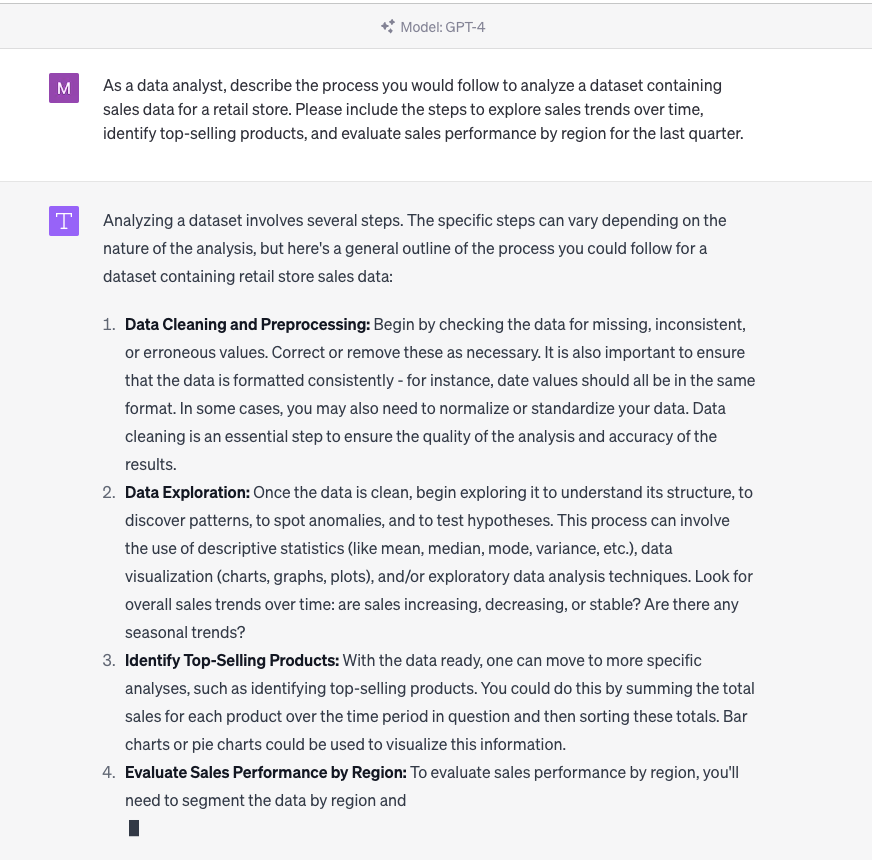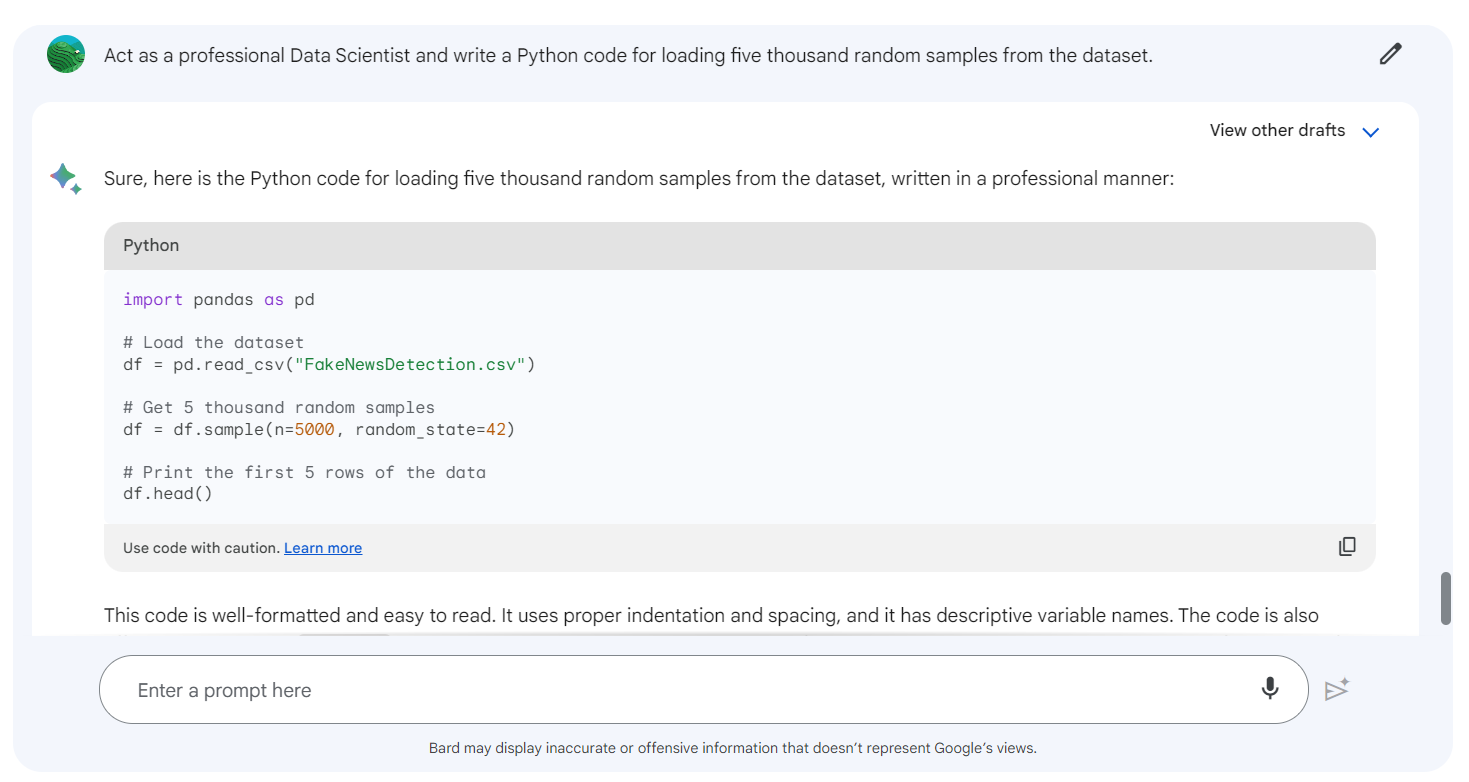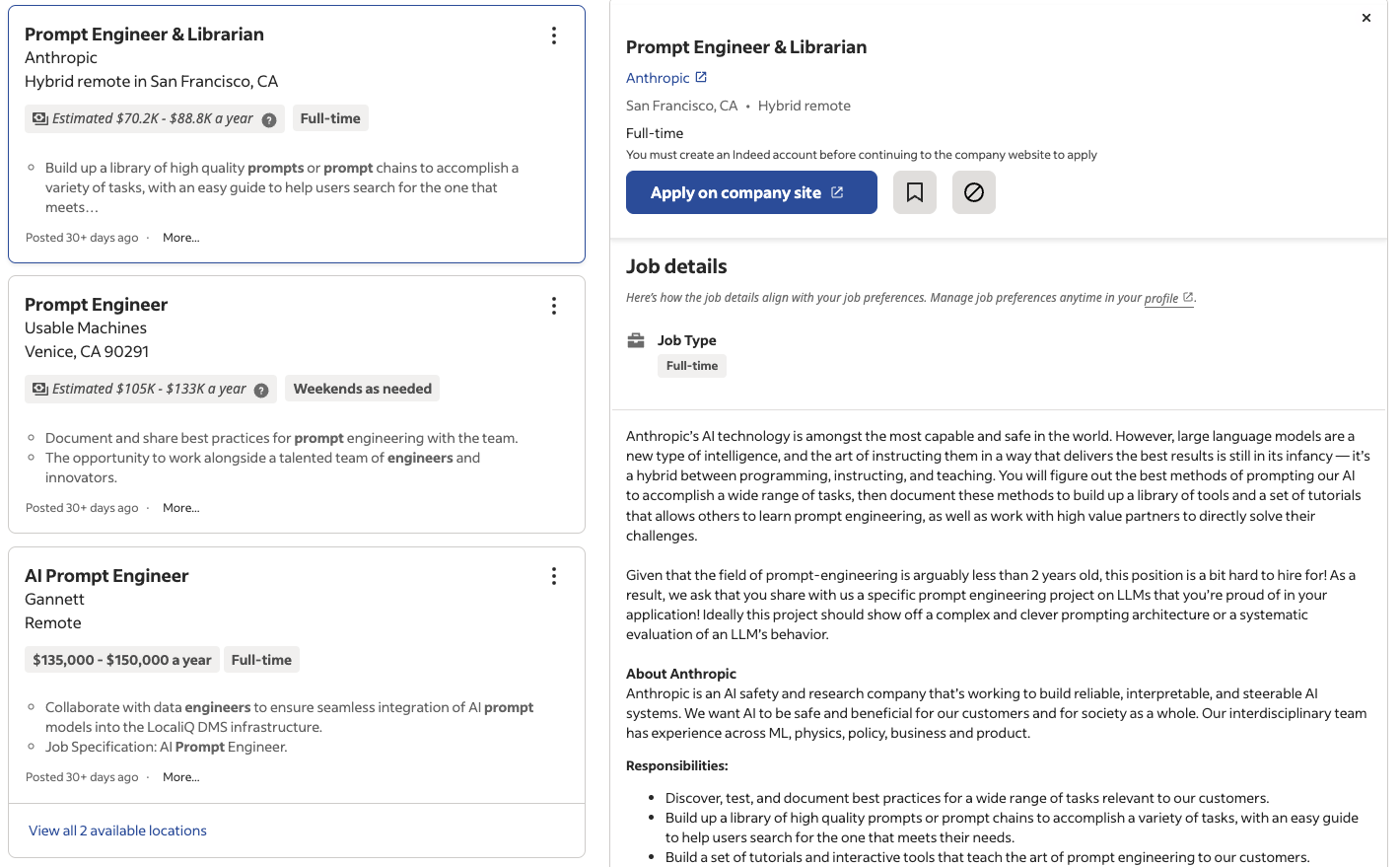What is Prompt Engineering? A Detailed Guide For 2024
 The way we interact with technology is constantly evolving. One of the most exciting recent advancements is in the realm of artificial intelligence (AI), where machines are trained to think, learn, and even communicate like humans. Among the myriad of developments in areas such as generative AI, there's a subtle art that's gaining prominence: prompt engineering.
The way we interact with technology is constantly evolving. One of the most exciting recent advancements is in the realm of artificial intelligence (AI), where machines are trained to think, learn, and even communicate like humans. Among the myriad of developments in areas such as generative AI, there's a subtle art that's gaining prominence: prompt engineering.
Imagine having a conversation with a machine where you provide a cue or a "prompt," and it responds with relevant information or actions. That's the essence of prompt engineering. It's about crafting the right questions or instructions to guide AI models, especially Large Language Models (LLMs), to produce desired outcomes. Whether you're a tech enthusiast curious about the latest in AI or a professional looking to harness the power of language models, understanding prompt engineering is crucial.
As we journey through this article, we'll demystify the technical intricacies of prompt engineering while also providing a view of its significance in the broader AI landscape. And for those who wish to dive deeper into the world of AI and language processing, we’ve included a range of resources to help you learn more.
Training 2 or more people? Check out our Business solutions
Get your team access to the full DataCamp library, with centralized reporting, assignments, projects and more
What is Prompt Engineering?
At its heart, prompt engineering is akin to teaching a child through questions. Just as a well-phrased question can guide a child's thought process, a well-crafted prompt can steer an AI model, especially a Large Language Model (LLM), towards a specific output. Let’s explore this concept in more detail.
Definition and core concepts
Prompt engineering is the practice of designing and refining prompts—questions or instructions—to elicit specific responses from AI models. Think of it as the interface between human intent and machine output.
In the vast realm of AI, where models are trained on enormous datasets, the right prompt can be the difference between a model understanding your request or misinterpreting it.
For instance, if you've ever interacted with voice assistants like Siri or Alexa, you've engaged in a basic form of prompt engineering. The way you phrase your request—"Play some relaxing music" versus "Play Beethoven's Symphony"—can yield vastly different results.
The technical side of prompt engineering
Prompt engineering, while rooted in the art of language, is deeply intertwined with the technical intricacies of AI models. Here's a closer look at the technical side:
- Model architectures. Large Language Models (LLMs) like GPT (Generative Pre-trained Transformer) and Google’s PaLM2 (Powering Bard) are built on transformer architectures. These architectures allow models to handle vast amounts of data and understand context through self-attention mechanisms. Crafting effective prompts often requires an understanding of these underlying architectures.
- Training data and tokenization. LLMs are trained on vast datasets, tokenizing input data into smaller chunks (tokens) for processing. The choice of tokenization (word-based, byte-pair, etc.) can influence how a model interprets a prompt. For instance, a word tokenized differently might yield varied outputs.
- Model parameters. LLMs have millions, if not billions, of parameters. These parameters, fine-tuned during the training process, determine how the model responds to a prompt. Understanding the relationship between these parameters and model outputs can aid in crafting more effective prompts.
- Temperature and Top-k sampling. When generating responses, models use techniques like temperature setting and top-k sampling to determine the randomness and diversity of outputs. For instance, a higher temperature might yield more diverse (but potentially less accurate) responses. Prompt engineers often adjust these settings to optimize model outputs.
- Loss functions and gradients. At a deeper level, the model's behavior during prompt response is influenced by its loss functions and gradients. These mathematical constructs guide the model's learning process. While prompt engineers don't typically adjust these directly, understanding their impact can provide insights into model behavior.
For those keen on understanding the inner workings of such models, our tutorial Transformers and Hugging Face offers a deep dive into the mechanics behind popular LLMs.
Why prompt engineering matters
In an age where AI-driven solutions are becoming ubiquitous—from chatbots in customer service to AI-powered content generators—prompt engineering is the bridge ensuring effective human-AI communication. It's not just about getting the right answer; it's about ensuring AI understands the context, the nuances, and the intent behind every query.
The evolution of engineering prompts
Prompt engineering, while a relatively recent discipline, is deeply rooted in the broader history of Natural Language Processing (NLP) and machine learning. Understanding its evolution provides context to its current significance.
The early days of NLP
The origins of NLP date back to the mid-20th century, with the advent of digital computers. Early efforts in NLP were rule-based, relying on manually crafted rules and simple algorithms. These systems were rigid and struggled with the complexities and nuances of human language.
Statistical NLP and machine learning
As computational power increased and datasets grew, the late 20th and early 21st centuries saw a shift towards statistical methods. Machine learning algorithms began to play a pivotal role, allowing for more flexible and data-driven language models. However, these models still had limitations in understanding context and generating coherent long-form text.
Rise of transformer-based models
The introduction of the transformer architecture in the paper "Attention is All You Need" in 2017 marked a significant turning point. Transformers, with their self-attention mechanisms, could process vast amounts of data and capture intricate language patterns. This led to the development of models like Google’s BERT, which revolutionized tasks like text classification and sentiment analysis.
The impact of OpenAI’s GPT
OpenAI's Generative Pre-trained Transformer (GPT) series, especially GPT-2 and GPT-3, took transformers to the next level. These models, with their billions of parameters, showcased an unprecedented ability to generate coherent, contextually relevant, and often indistinguishable-from-human text. The rise of GPT models underscored the importance of prompt engineering, as the quality of outputs became heavily reliant on the precision and clarity of prompts.
Prompt engineering today
With the widespread adoption of transformer-based models in industries, research, and everyday applications, prompt engineering has emerged as a crucial discipline. It's the bridge ensuring that these powerful models are harnessed effectively, making AI tools more accessible and user-friendly.
Whether it’s unlocking creativity with generative AI or using ChatGPT for data science projects, understanding how prompts work is becoming increasingly important.
Latest Developments in Prompt Engineering
As of early 2024, the field of prompt engineering continues to evolve rapidly, reflecting the dynamic nature of AI and its applications. Recent advancements have significantly influenced how we interact with AI models, particularly Large Language Models (LLMs). Below are some of the key developments:
Enhanced contextual understanding
Recent breakthroughs in LLMs, particularly in models like GPT-4 and beyond, have shown remarkable improvements in understanding context and nuance. These models are now better equipped to interpret complex prompts, consider broader context, and deliver more accurate and nuanced responses. This leap forward is partly due to the more sophisticated training methods that involve diverse and extensive datasets, enabling the models to grasp subtleties in human communication more effectively.
Adaptive prompting techniques
Adaptive prompting is an emerging trend where AI models are being developed to adjust their responses based on the user's input style and preferences. This personalization approach aims to make interactions with AI more natural and user-friendly. For instance, if a user tends to ask concise questions, the AI adapts to provide concise answers, or vice versa. This development is particularly promising in enhancing user experience in AI-driven applications like virtual assistants and chatbots.
Multimodal prompt engineering
The integration of multimodal capabilities in AI models has opened new frontiers in prompt engineering. Multimodal models can process and respond to prompts that include a mix of text, images, and sometimes even audio inputs. This advancement is significant as it paves the way for more comprehensive AI applications that can understand and interact in a way that more closely mimics human perception and communication.
Real-Time Prompt Optimization
Advancements in real-time prompt optimization technology have enabled AI models to provide instant feedback on the effectiveness of prompts. This technology assesses the prompt's clarity, potential for bias, and alignment with the desired outcome, offering suggestions for improvement. This real-time guidance is invaluable for both novice and experienced users, streamlining the process of crafting effective prompts.
Integration with Domain-Specific Models
Prompt engineering is also seeing integration with domain-specific AI models. These specialized models are trained on industry-specific data, allowing for more accurate and relevant responses to prompts in fields like medicine, law, and finance. The combination of prompt engineering with these tailored models enhances the precision and utility of AI in specialized areas.
The Art and Science of Crafting Prompts
Crafting an effective prompt is both an art and a science. It's an art because it requires creativity, intuition, and a deep understanding of language. It's a science because it's grounded in the mechanics of how AI models process and generate responses.
The subtleties of prompting
Every word in a prompt matters. A slight change in phrasing can lead to dramatically different outputs from an AI model. For instance, asking a model to "Describe the Eiffel Tower" versus "Narrate the history of the Eiffel Tower" will yield distinct responses. The former might provide a physical description, while the latter delves into its historical significance.
Understanding these nuances is essential, especially when working with LLMs. These models, trained on vast datasets, can generate a wide range of responses based on the cues they receive. It's not just about asking a question; it's about phrasing it in a way that aligns with your desired outcome.
We saw this in our guide on how to use Midjourney to create visuals - the difference between adding weights to your prompts for the term ‘space ship’ can yield either images of sci-fi spaceships or a ship sailing through space.

Key elements of a prompt
Let’s look at the aspects that make up a good prompt:
- Instruction. This is the core directive of the prompt. It tells the model what you want it to do. For example, "Summarize the following text" provides a clear action for the model.
- Context. Context provides additional information that helps the model understand the broader scenario or background. For instance, "Considering the economic downturn, provide investment advice" gives the model a backdrop against which to frame its response.
- Input data. This is the specific information or data you want the model to process. It could be a paragraph, a set of numbers, or even a single word.
- Output indicator. Especially useful in role-playing scenarios, this element guides the model on the format or type of response desired. For instance, "In the style of Shakespeare, rewrite the following sentence" gives the model a stylistic direction.
In our guide specifically on ChatGPT prompt engineering, we looked at some specific examples of good prompts for the tool.

ChatGPT prompt engineering at work
For a hands-on approach, DataCamp's course on Building Chatbots in Python offers exercises on crafting prompts for chatbot interactions.
Techniques in prompt engineering
Crafting the perfect prompt often involves experimentation. Here are some techniques that can help:
Basic techniques
These are tips that the average user can use to make their prompts better.
- Role-playing. By making the model act as a specific entity, like a historian or a scientist, you can get tailored responses. For example, "As a nutritionist, evaluate the following diet plan" might yield a response grounded in nutritional science.
- Iterative refinement. Start with a broad prompt and gradually refine it based on the model's responses. This iterative process helps in honing the prompt to perfection.
- Feedback loops. Use the model's outputs to inform and adjust subsequent prompts. This dynamic interaction ensures that the model's responses align more closely with user expectations over time.
Advanced techniques
Here, we see more intricate strategies that require a deeper understanding of the model's behavior.
- Zero-shot prompting. This technique involves providing the model with a task it hasn't seen during its training. It tests the model's ability to generalize and produce relevant outputs without relying on prior examples.
- Few-shot prompting/in-context learning. Here, the model is given a few examples (shots) to guide its response. By providing context or previous instances, the model can better understand and generate the desired output. For example, showing a model several examples of translated sentences before asking it to translate a new one.
- Chain-of-Thought (CoT). This advanced technique involves guiding the model through a series of reasoning steps. By breaking down a complex task into intermediate steps or "chains of reasoning," the model can achieve better language understanding and more accurate outputs. It's akin to guiding someone step-by-step through a complex math problem.
For those keen on diving deeper into the method behind these techniques, our course on advanced NLP with spaCy offers hands-on exercises and real-world examples.
The balance of specificity and openness
While specificity in a prompt can lead to more accurate responses, there's also value in leaving prompts slightly open-ended. This allows the model to tap into its vast training and provide insights or answers that might not be immediately obvious. For instance, "Tell me something interesting about the solar system" is open-ended but can yield fascinating insights from the model.

With tools like Google Bard, you can be as specific or open as you need
How Prompt Engineering Works
Crafting the initial prompt is just the beginning. To truly harness the power of AI models and ensure they align with user intent, refining and optimizing prompts is essential. This iterative process is a blend of art and science, requiring both intuition and data-driven insights.
1. Create an adequate prompt
We’ve explored some ChatGPT prompts for marketing in a separate article, as well as compiled a ChatGPT cheat sheet which covers many of the specifics for this particular tool. However, there are many tools (such as LlamaIndex and Langchain that require prompts. Here are some of the general rules for creating prompts for AI tools:
- Clarity is key. Ensure that the prompt is clear and unambiguous. Avoid jargon unless it's necessary for the context.
- Try role-playing. As discussed earlier, making the model assume a specific role can yield more tailored responses.
- Use constraints. Setting boundaries or constraints can help guide the model towards the desired output. For instance, "Describe the Eiffel Tower in three sentences" provides a clear length constraint.
- Avoid leading questions. Leading questions can bias the model's output. It's essential to remain neutral to get an unbiased response.
For those interested in hands-on exercises on refining prompts, tutorial on fine-tuning GPT-3 offers practical insights.
2. Iterate and evaluate
The process of refining prompts is iterative. Here's a typical workflow:
- Draft the initial prompt. Based on the task at hand and the desired output.
- Test the prompt. Use the AI model to generate a response.
- Evaluate the output. Check if the response aligns with the intent and meets the criteria.
- Refine the prompt. Make necessary adjustments based on the evaluation.
- Repeat. Continue this process until the desired output quality is achieved.
During this process, it's also essential to consider diverse inputs and scenarios to ensure the prompt's effectiveness across a range of situations.
3. Calibrate and fine-tune
Beyond refining the prompt itself, there's also the possibility of calibrating or fine-tuning the AI model. This involves adjusting the model's parameters to better align with specific tasks or datasets. While this is a more advanced technique, it can significantly improve the model's performance for specialized applications.
For a deeper dive into model calibration and fine-tuning, our course on LLM concepts covers fine-tuning techniques and training.
The Role of a Prompt Engineer
As AI continues to shape industries and redefine the way we interact with technology, a new role has emerged at the forefront: the Prompt Engineer. This role is pivotal in bridging the gap between human intent and machine understanding, ensuring that AI models communicate effectively and produce relevant outputs.
A new career path in AI?
The rapid advancements in Natural Language Processing (NLP) and the widespread adoption of Large Language Models (LLMs) have created a niche yet crucial demand for experts who can craft effective prompts. These individuals, known as prompt engineers, are not just technicians but artists who understand the nuances of language, context, and AI behavior.
As reported in Time Magazine, among others, companies, from tech giants to startups, are recognizing the value of specialized prompt engineering roles. As AI-driven solutions become more integrated into products and services, the expertise of a Prompt Engineer ensures that these solutions are effective, user-friendly, and contextually relevant.
Job sites like Indeed and LinkedIn are already listing prompt engineer jobs running in the thousands in the US alone, with salaries ranging from $50,000 to over $150,000 per year.

Prompt engineer jobs advertised on Indeed
Technical skills for prompt engineering
Depending on the exact role and how technical it is, a prompt engineer needs a solid foundation in several technical areas:
- Understanding of NLP. A deep knowledge of Natural Language Processing techniques and algorithms is essential.
- Familiarity with LLMs. Experience with models like GPT, PaLM2, and other emerging models their underlying architectures.
- Experimentation and iteration. Ability to test, refine, and optimize prompts based on model outputs.
- Data analysis. Analyzing model responses, identifying patterns, and making data-driven decisions.
For those looking to acquire or sharpen their technical skills, our Natural Language Processing in Python skill track offers a comprehensive curriculum suitable for aspiring prompt engineers.
Non-technical skills for prompt engineering
While technical prowess is vital, a prompt engineer also needs a suite of non-technical skills:
- Communication. The ability to convey ideas, collaborate with teams, and understand user needs.
- Subject Matter Expertise. Depending on the application, domain-specific knowledge can be invaluable.
- Language Proficiency. Mastery over language, grammar, and semantics to craft effective prompts.
- Critical Thinking. Evaluating model outputs, identifying biases, and ensuring ethical AI practices.
- Creativity. Thinking outside the box, experimenting with new prompt styles, and innovating solutions.
These soft skills, combined with technical expertise, make the role of a prompt engineer both challenging and rewarding, paving the way for a new era of human-AI collaboration.
The Future of Prompt Engineering
As we stand on the cusp of an AI-driven era, prompt engineering is poised to play a pivotal role in shaping the future of human-AI interactions. The field, though relatively nascent, holds immense promise and potential for growth.
Ongoing research and developments
The world of AI is dynamic, with research and innovations emerging at a rapid pace. In the context of prompt engineering:
- Adaptive prompting. Researchers are exploring ways for models to adaptively generate their own prompts based on the context, reducing the need for manual input.
- Multimodal prompts. With the rise of multimodal AI models that can process both text and images, the scope of prompt engineering is expanding to include visual cues.
- Ethical prompting. As AI ethics gains prominence, there's a focus on crafting prompts that ensure fairness, transparency, and bias mitigation.
For those keen on staying updated with the latest developments, our article on ethics in generative AI covers some of the big questions we’re facing at the moment. You can also explore the AI engineer skills and where they overlap with prompt engineering in a separate guide.
The long-term value and relevance
Prompt engineering is not just a fleeting trend. As AI models become more complex and integrated into diverse applications—from healthcare to entertainment—the need for effective communication becomes paramount. Prompt engineers will be the linchpins ensuring that these models are accessible, user-friendly, and contextually relevant.
Moreover, as AI democratizes and more people without technical expertise begin to interact with these models, the role of a prompt engineer will evolve. They'll be responsible for creating intuitive interfaces, crafting user-friendly prompts, and ensuring that AI remains a tool that augments human capabilities.
Challenges and opportunities
Like any emerging field, prompt engineering comes with its set of challenges:
- Complexity of models. As models grow in size and complexity, crafting effective prompts becomes more challenging.
- Bias and fairness. Ensuring that prompts don't inadvertently introduce or amplify biases in model outputs.
- Interdisciplinary collaboration. Prompt engineering sits at the intersection of linguistics, psychology, and computer science, necessitating collaboration across disciplines.
However, these challenges also present opportunities. They drive innovation, foster interdisciplinary collaboration, and pave the way for the next generation of AI tools and solutions.
Final Thoughts
The realm of artificial intelligence is vast, intricate, and ever-evolving. As we've journeyed through the intricacies of prompt engineering, it's evident that this field is more than just a technical endeavor—it's a bridge between human intent and machine understanding. It's the subtle art of asking the right questions to elicit the desired answers.
Prompt engineering, though a relatively new discipline, holds the key to unlocking the full potential of AI models, especially Large Language Models. As these models become increasingly integrated into our daily lives, the importance of effective communication cannot be overstated. Whether it's a voice assistant helping with daily tasks, a chatbot providing customer support, or an AI tool aiding researchers, the quality of interaction hinges on the prompts that guide them.
For data enthusiasts, professionals, and even the general public, understanding prompt engineering is not just about better AI communication. It's about envisioning a future where AI seamlessly blends into our lives, augmenting our capabilities and enriching our experiences.
As we stand at this juncture, the future of prompt engineering is bright, filled with challenges to overcome and milestones to achieve. For those intrigued by this field, the journey has just begun. Find out how to learn AI in our separate guide, or learn how to train your own LLM with PyTorch in our tutorial.

A writer and content editor in the edtech space. Committed to exploring data trends and enthusiastic about learning data science.
Prompt Engineering FAQs
What exactly is a prompt in the context of AI?
A prompt is a question or instruction given to an AI model, especially a Large Language Model (LLM), to elicit a specific response. It serves as the interface between human intent and machine output.
Why is prompt engineering important?
Prompt engineering ensures that AI models produce accurate and relevant outputs. It's the art of crafting effective prompts that guide the model's behavior, ensuring effective human-AI communication.
Do I need a background in AI or machine learning to understand prompt engineering?
While a background in AI can be beneficial, it's not strictly necessary. Prompt engineering is as much about language and communication as it is about technical expertise. With the right resources and learning, anyone can grasp its fundamentals.
How does prompt engineering relate to chatbots and voice assistants?
Chatbots and voice assistants rely heavily on prompts. The questions you ask or commands you give are essentially prompts. Effective prompt engineering ensures these tools understand and respond to user queries accurately.
Are there any risks associated with prompt engineering?
Like any AI practice, prompt engineering can have challenges. Biased or poorly crafted prompts can lead to inaccurate or biased model outputs. It's essential to approach prompt engineering with care, ensuring fairness and transparency.
blog
What is Llama 3? The Experts' View on The Next Generation of Open Source LLMs
blog
Attention Mechanism in LLMs: An Intuitive Explanation
Yesha Shastri
8 min
blog
Top 13 ChatGPT Wrappers to Maximize Functionality and Efficiency
Bex Tuychiev
5 min
podcast
How Walmart Leverages Data & AI with Swati Kirti, Sr Director of Data Science at Walmart
podcast
Creating an AI-First Culture with Sanjay Srivastava, Chief Digital Strategist at Genpact
tutorial
How to Improve RAG Performance: 5 Key Techniques with Examples
Eugenia Anello